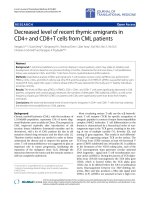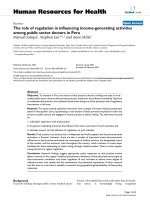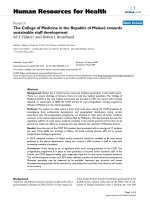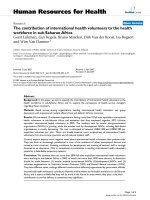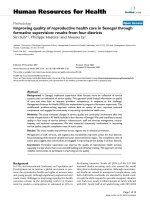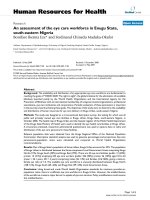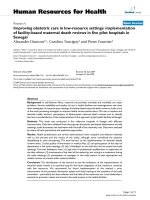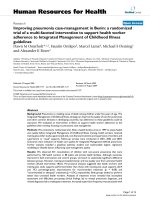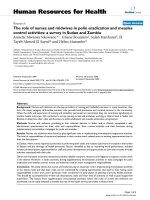báo cáo sinh học:" Improving quality of reproductive health care in Senegal through formative supervision: results from four districts" ppt
Bạn đang xem bản rút gọn của tài liệu. Xem và tải ngay bản đầy đủ của tài liệu tại đây (286.43 KB, 12 trang )
BioMed Central
Page 1 of 12
(page number not for citation purposes)
Human Resources for Health
Open Access
Methodology
Improving quality of reproductive health care in Senegal through
formative supervision: results from four districts
Siri Suh*
1
, Philippe Moreira
2
and Moussa Ly
2
Address:
1
University of Michigan Population Fellow, Management Sciences for Health Cambridge, MA 02139, USA and
2
Management Sciences for
Health, Cambridge, MA 02139, USA
Email: Siri Suh* - ; Philippe Moreira - ; Moussa Ly -
* Corresponding author
Abstract
Background: In Senegal, traditional supervision often focuses more on collection of service
statistics than on evaluation of service quality. This approach yields limited information on quality
of care and does little to improve providers' competence. In response to this challenge,
Management Sciences for Health (MSH) has implemented a program of formative supervision. This
multifaceted, problem-solving approach collects data on quality of care, improves technical
competence, and engages the community in improving reproductive health care.
Methods: This study evaluated changes in service quality and community involvement after two
rounds of supervision in 45 health facilities in four districts of Senegal. We used checklists to assess
quality in four areas of service delivery: infrastructure, staff and services management, record-
keeping, and technical competence. We also measured community involvement in improving
service quality using the completion rates of action plans.
Results: The most notable improvement across regions was in infection prevention.
Management of staff, services, and logistics also consistently improved across the four districts.
Record-keeping skills showed variable but lower improvement by region. The completion rates of
action plans suggest that communities are engaged in improving service quality in all four districts.
Conclusion: Formative supervision can improve the quality of reproductive health services,
especially in areas where there is on-site skill building and refresher training. This approach can also
mobilize communities to participate in improving service quality.
Background
In 1994, the International Conference on Population and
Development set in motion a global movement to pro-
mote the reproductive health and rights of women, men
and young people. Although significant progress has been
made, many challenges to improving reproductive health
outcomes remain in the developing world [1]. Unmet
need for modern contraception in estimated at 29% in
developing countries. Nearly all (99%) of the 529 000
maternal deaths occurring each year around the world
take place in developing countries. Although most mater-
nal deaths are related to unexpected complications, only
half of all births worldwide are attended by health work-
ers with the skills required to provide emergency obstetric
care. Each year, nearly 5 million people are newly infected
with HIV. Nearly half of all adults living with HIV/AIDS
Published: 29 November 2007
Human Resources for Health 2007, 5:26 doi:10.1186/1478-4491-5-26
Received: 24 July 2006
Accepted: 29 November 2007
This article is available from: />© 2007 Suh et al; licensee BioMed Central Ltd.
This is an Open Access article distributed under the terms of the Creative Commons Attribution License ( />),
which permits unrestricted use, distribution, and reproduction in any medium, provided the original work is properly cited.
Human Resources for Health 2007, 5:26 />Page 2 of 12
(page number not for citation purposes)
are women and in sub-Saharan Africa, almost 60% of
HIV-positive adults are women [1]. In recent years, a
growing recognition of the importance of quality of care
in improving sexual and reproductive health has emerged.
Although evidence shows that access to services is crucial
to improving reproductive health outcomes, health pro-
grammers and policymakers are increasingly aware that
successful reproductive health strategies must also address
service quality [1-3].
Part of the response to the imperative of improved quality
of care has been the emergence of alternative forms of
supervision. In contrast to traditional models that have a
limited focus on data collection and analysis of results,
these new approaches focus on joint problem-solving,
immediate feedback, and communication between super-
visor and provider. Management Sciences for Health
(MSH) is implementing formative supervision, an inno-
vative approach to supervision of reproductive health care
that involves the community, in Senegal. This paper
describes the formative supervision approach and evalu-
ates changes in service quality after two rounds of forma-
tive supervision in four districts of Senegal.
Supervision and quality
Approaches to improving quality of care have usually
focused on training providers and upgrading infrastruc-
ture and equipment [4], and better supervision of provid-
ers has often been a part of these strategies [5]. In her
framework for quality of care of reproductive health,
Bruce points to supervision as an underpinning of techni-
cal competence [6]. Supervision entails a range of activi-
ties, including observation of providers' performance,
data collection, and a reinforcement of job descriptions,
skills, institutional norms and protocols. Beyond these
technical elements, in some settings supervision plays an
important role in personalizing the health system for serv-
ice providers, whose contact with the administration of
the health system is often limited to supervisory visits [5].
Taken together, these activities compose the four main
objectives of supervision as defined by US Agency for
International Development's (USAID's) Maximizing
Access and Quality Initiative: setting expectations, moni-
toring and evaluation of performance, identifying prob-
lems and opportunities for improvement, and mobilizing
action [5].
In many settings, supervision takes the limited form of
inspecting performance against checklists. This fault-find-
ing approach may demoralize health workers and under-
mine joint problem-solving and action, so health
programmers and providers favor forms of supervision
that focus on addressing problems in service delivery
[5,7,8]. One such approach, developed by Engender-
Health and called "facilitative supervision", emphasizes a
comprehensive analysis of the factors that shape a pro-
vider's ability to perform his or her job. This approach
emphasizes mentoring, joint problem-solving, and open
communication [9].
Evidence for alternative approaches to supervision
Evidence from program evaluations and research studies
in various countries suggests that facilitative or supportive
supervision promotes service quality. In six coun-
tries–Bangladesh, Brazil, Honduras, Kenya, Nepal, and
Tanzania–the introduction of supportive supervision as
part of service improvement initiatives has yielded prom-
ising results in both service quality and provider perform-
ance [5]. Research findings offer more rigorous support
for alternative forms of supervision. One of the earliest
examples is taken from the 1980s in Brazil, where adop-
tion of a self-assessment approach to supervision at a
community-based family planning distribution program
not only improved performance, but also increased the
number of providers supervised and reduced the cost of
supervision [10]. Studies in Guatemala, Mexico, and
Indonesia have also noted the effectiveness of self-assess-
ment as a supervisory tool [11-13]. Other studies in Zim-
babwe, Nigeria, Nepal, and Malawi indicate that
structured observation using checklists and immediate
feedback also leads to improved performance [14-17].
The situation in Senegal
In Senegal, there is a significant need for high-quality sex-
ual and reproductive health care. The contraceptive prev-
alence rate for modern methods is low (10%) [18].
Although 93% of women receive prenatal care, skilled
providers attend just over half of all births (52%) [18].
Norms and protocols for reproductive health care, defined
by the Ministry of Health, state the objectives, tools, and
frequency required for supervision. According to these
standards, the objectives of supervision are to provide
refresher training, improve working conditions, and moti-
vate and support health workers. Supervisors are sup-
posed to use checklists to assess working conditions and
the technical competence of staff. Supervisors are also
expected to evaluate the job descriptions of various cate-
gories of providers [19]. Community health structures are
supervised every month, while health posts are supervised
every two months. Facilities at the district and regional
levels receive supervision every three and six months,
respectively. However, evidence suggests serious lapses in
the observation of supervision protocols. The frequency of
supervision by local authorities is often inconsistent, and
the tools and activities associated with supervision are not
applied in a standard fashion at all health facilities due to
resource and organizational constraints [20,21]. One
study found that in the last six months, most facilities
(60%) received one or two visits. However, nearly 31% of
Human Resources for Health 2007, 5:26 />Page 3 of 12
(page number not for citation purposes)
facilities did not receive any supervision. Under these con-
ditions, the capacity of supervision to improve service
quality has been limited.
In addition, under the classic supervision system, the data
available is often difficult to analyse. For example, family
planning and maternal health data is often expressed in
terms of the availability, accessibility, and utilization of
services by region [22]. While an interregional compari-
son of the data is interesting, it provides a limited under-
standing of quality of care and the technical competence
of providers in each region. It is also unclear what these
indicators represent and how they are measured. Availa-
bility may represent the availability of services, or the
number of health workers trained to provide services.
Accessibility can refer to financial or geographic access, or
even cultural acceptability of services. The data fails to
provide the information needed to develop activities
geared toward improving quality of care.
The formative supervision intervention in Senegal
To address the gap between information and program-
ming to improve quality and to reinforce the technical
competence of providers, we implemented formative
supervision. This type of supportive supervision combines
observation with a problem-solving approach to clinical,
logistic, and information, education, and communication
(IEC) problems in health service delivery. This approach
differs from other supportive supervision approaches in
two ways. Firstly, formative supervision draws on a range
of tools and activities designed to assess the technical
competence of providers in the delivery of reproductive
health care. Secondly, formative supervision includes the
community in the supervision process by orienting com-
munity representatives towards a rights-based approach
to service quality.
Using the Ministry's Norms and Protocols for Sexual and
Reproductive Health of 2000, in 2002 we developed a
checklist to evaluate the quality of sexual and reproduc-
tive health care. Partners included the United Nations
Population Fund, the United Nations Fund for Children,
the World Health Organization, and USAID and several of
its cooperating agencies. Local nongovernmental organi-
zations such as Santé Familiale (Family Health, or SAN-
FAM) and l'Association Sénégalaise pour le Bien-Etre de la
Famille (Senegalese Association for the Well-Being of the
Family, or ASBEF) also participated in developing the
checklist.
We pre-tested the checklist at several health facilities in the
regions of Louga and Thiès in 2003. Since then, we have
implemented formative supervision in various districts of
USAID's six intervention regions. In each district, all
health posts and health centers offering reproductive
health services were selected to receive a total of two
supervision visits over the course of the program. A total
of 323 facilities in six regions were visited during the first
round of supervision. The second round of supervision
began in July 2005 in the region of Thiès. Table 1 shows
where formative supervision was implemented in the six
intervention regions between 2003 and 2005.
Formative supervision tools
Formative supervision uses four tools to assess quality of
care with a problem-solving approach: the supervision
checklist, the infection prevention exercise, the COPE
exercise [23], and the Inventory Management Assessment
Tool (IMAT) [24]. The checklist and IMAT obtain quanti-
tative data on provider and facility performance. The
infection prevention and COPE exercises, both qualitative
tools, mobilize providers and community members to
collaborate to evaluate service quality and identify solu-
tions for quality improvement.
As in other supervisory approaches, much of the supervi-
sion visit revolves around the completion of the checklist.
Supervisors use direct observation to compare perform-
ance to the checklist and provide immediate feedback to
providers. The checklist used for formative supervision is
Table 1: Formative supervision in six regions of Senegal, 2003–2005
Visit 1, 2003–2005 Visit 2, 2005
Region Districts Health
centers
Health
posts
Reference
centers
Maternities Total Districts Health
centers
Health
posts
Reference
centers
Maternities Total
Dakar 3 0 10 0 2 12 0 0 0 0 0 0
Fatick 1 1 4 0 0 5 0 0 0 0 0 0
Kaolack 4 4 52 0 0 56 0 0 0 0 0 0
Louga 5 5 61 1 0 67 2 1 21 0 0 22
Thiès 7 8 98 0 0 106 2 3 20 0 0 23
Ziguinchor 4 2 73 0 2 77 0 0 0 0 0 0
Total 24 20 298 1 4 323 4 4 41 0 0 45
Human Resources for Health 2007, 5:26 />Page 4 of 12
(page number not for citation purposes)
different from other checklists in three respects. First, it
integrates the clinical, logistic, and IEC components of
service quality by evaluating the following indicators:
• Availability and quality of infrastructure and equip-
ment;
Human resources and services management (organization
and availability of health services; record-keeping; com-
munity involvement; functionality of the facility's man-
agement committee; and functionality of the community-
based health committee);
• Technical competence of health workers in providing
clinical and IEC services;
• Accuracy in drug supply record-keeping and effective-
ness of stock management.
Second, by including sections appropriate for supervision
of various types of facilities, the checklist is adaptable to
the range of health facilities in the national health care
system: health posts, health centers, regional hospitals,
and national hospitals. For example, the checklist of
essential drugs is more extensive for hospitals than for
health posts. Third, the checklist calculates quantifiable
measures of performance for immediate feedback. For
each area of reproductive health service delivery, we calcu-
late a score according to the points gained out of the total
number of points on the checklist during the observation
period. We then convert the score to a percentage that can
be analysed at the facility, district, and regional levels. Fig-
ure 1 illustrates the completed first page of the section on
infection prevention in the checklist.
The second tool used during formative supervision is a
live demonstration of the infection prevention exercise
adapted from the EngenderHealth model. Supervisors
demonstrate four steps of infection prevention: hand-
washing; use of protective barriers (gloves); treatment of
instruments (decontamination, cleaning, sterilization,
and high-level disinfection); and elimination of waste.
Using buckets, gloves, and various cleaning agents, the
supervisor explains the concept and importance of infec-
tion prevention to providers and community members.
Providers are invited to demonstrate their infection pre-
vention skills to the audience. The supervisor identifies
opportunities for improvement in the providers' tech-
niques and encourages questions and feedback from the
audience. Community members are encouraged to partic-
ipate not only to observe, but also to mobilize community
support for the purchase of infection prevention supplies.
Next, the COPE exercise orients clients and providers to a
rights-based approach to reproductive health service
delivery. Using materials adapted from the Engender-
Health model, providers complete self-assessments to
evaluate their own performance. Supervisors administer
questionnaires to clients to assess their perceptions of
service delivery. Drawing on the data collected from these
tools, the supervisors lead a group discussion with provid-
ers and community representatives on rights-based con-
cepts of service delivery from the perspectives of both
clients and providers. The supervisors then combine the
highlights of this discussion with their observations from
the checklist to guide the development of action plans for
community members and providers to improve quality of
care.
Figure 2 illustrates the first page of an action plan com-
pleted in 2003 at a health facility in the district of Kebe-
mer in Louga. Action plans include tasks that fall under
the COPE model, including the right of the client to infor-
mation, choice, safety, privacy, comfort, and confidential-
ity. Plans also address the human resource needs of health
providers. The action plan committee designates who is
responsible for completing each task. While providers are
responsible for improving technical areas of service deliv-
ery such as stock management, infection prevention, and
clinical management, the community often shares the
responsibility for improving or upgrading the facility and
its equipment. Nearly every facility has a health commit-
tee, which is responsible for representing community
interests. Health committees also often assume responsi-
bility for mobilizing financial support or labor from the
community. Communities have repaired or constructed
incinerators for elimination of medical waste, constructed
signs with prices and hours of service, and erected road
signs indicating the location and services of the nearest
health facility.
The participation of community members in the process
of quality improvement is perhaps the most innovative
aspect of formative supervision. To assess community
involvement, we used the completion rates of action plans
developed collaboratively by providers and community
members during supervision visits. Completion rates
serve as an indirect measure of the participation of com-
munity members in helping to complete tasks related to
quality improvement.
The fourth tool used in formative supervision is the Inven-
tory Management Assessment Tool (IMAT). Developed by
MSH in Haiti in 1997, the IMAT is used to assess the accu-
racy of stock registration and the effectiveness of drug sup-
ply management for up to 25 commonly used drugs.
Table 2 lists the IMAT indicators. By examining both stock
records and physical stock, supervisors obtain the data
Human Resources for Health 2007, 5:26 />Page 5 of 12
(page number not for citation purposes)
required to calculate the IMAT indicators. Stock managers
are invited to participate so that they learn to use the tool
themselves, and supervisors share the results with them to
identify strategies for improving inventory record-keeping
and management. In addition to applying IMAT, supervi-
sors often assist stock managers in physically reorganizing
storage units to facilitate identification and storage of
medical supplies.
Methods
We used two primary sources of data to assess how form-
ative supervision affected service quality and community
involvement in improving service quality. To measure
changes in service quality between the two rounds of
supervision, we calculated percentages of satisfactory per-
formance in the areas defined in the supervision checklist.
To measure community involvement in improving service
Example of page 1 of infection prevention in supervision checklistFigure 1
Example of page 1 of infection prevention in supervision checklist. 1. The number of checked boxes in each column
determines the total score for each section, e.g., in the section on hand washing and drying, 2 items were marked "Satisfactory"
and 1 item was marked "Needs improvement." The total score is 2/3 or 67%. We determine the total score for Infection Pre-
vention by adding all the items marked "Satisfactory" and dividing by the total number of items in the section. 2. If all the condi-
tions in a multiple component question are not observed, the supervisor marks the "Needs improvement" column and makes
remarks in the "Observations" column to provide necessary feedback.
I: Hand washing and drying
Satisfactory
Needs
improvement
Not
observed
Observations
1. Washes hands with soap and water and soap or with antibacterial
solution before and after each patient according to the norms
X
2. Washes hands with soap and water or with antibacterial solution
before wearing gloves and after removing gloves according to the
norms
X
3. Dries hands with personal towel that is clean and dry or air dries
hands according to the norms
X
TOTAL
1
2
3
1
3
0
3
Per cent satisfactory:
67%
II: Use of protective barriers
Satisfactory
Needs
improvement
Not
observed
Observations
1. Wears a smock that covers chest and arms adequately X
2. Wears household gloves before handling waste or soiled
equipment
X
3. Decontaminates household gloves before removal X
4. Wears gloves each time there is risk of exposure to blood or other
organic liquids
X
5. Wears a smock, mask, hairnet, glasses, and shoe covers
2
X Provider not wearing
smock or hairnet
TOTAL
3
5
2
5
0
5
Per cent satisfactory:
60%
III: Decontamination
Satisfactory
Needs
improvement
Not
observed
Observations
1. Prepares a chlorinated solution (0.5%) X
2. Soaks used instruments in decontamination solution for 10
minutes
X
3. Removes instruments after 10 minutes X
Human Resources for Health 2007, 5:26 />Page 6 of 12
(page number not for citation purposes)
quality, we analysed the completion of action plans devel-
oped collaboratively by health providers and community
members.
Assessing service quality
Health districts included in the study
We collected and analyzed data from the application of
the checklists in two rounds of supervision in the districts
of Tivaoune and Khombole in the region of Thiès and the
districts of Kebemer and Louga in the region of Louga. Of
the more than 300 health facilities in these four districts,
45 facilities received two supervision visits: 23 in
Tivaoune and Khombole and 22 in Kebemer and Louga.
The total population covered by the district of Tivaoune is
185 250; in Khombole, the population covered is 244
000. The district of Kebemer covers a population of 149
444; in Louga, the population covered is 340 472.
Areas of service delivery included in the study
We specified four areas of service delivery in the analysis:
infrastructure, management of staff and services, record-
keeping, and technical competence. The checklist con-
tains indicators of quality for each area of service delivery.
Infrastructure refers to the condition of the facility and its
surrounding, the state of equipment and supplies, and the
physical layout of the facility. Management of staff and serv-
ices refers to human resource management strategies and
tools, such as the existence of job descriptions and event
calendars, appropriate delegation of tasks, and integration
of health services. Record-keeping represents the mainte-
nance of registers and patient records for family planning,
prenatal care, and delivery care. Technical competence
measures providers' performance in family planning and
prenatal care consultations, individual and group coun-
seling, infection prevention, and logistics management.
Action plan for health post Bandegne (District Kebemer, Region of Louga)Figure 2
Action plan for health post Bandegne (District Kebemer, Region of Louga).
Action Plan for Health Post Bandegne (District Kebemer, Region of Louga)
Problems Causes Solutions People
Responsible
Follow-Up
Managers
Deadline for
Execution
Client Right to Information
Lack of information
among staff about the
cost, type and hours of
reproductive health
services
- Absence of boards, signs, or posters in the
facility that indicate the cost, type and hours of
reproductive health services
- Lack of clarity among personnel about
national reproductive health policies, norms and
procedures
- Design and display signs
- Organize day of orientation for
personnel to review policies, norms and
procedures
Health Committee
Chief Nurse of
Facility
Hé Fall Thiéllo
Fatou Ndiaye
Nov. 3, 2003
Oct. 31, 2003
Lack of reproductive
health education
program for clients
- Insufficient materiel for information,
education and communication (IEC)
- Absence of calendar for group counseling in
the facility
- Absence of group counseling sessions in
reproductive health
- Complete IEC material in
collaboration with district IEC agents
- Develop and display a calendar for
group counseling
- Organize group counseling once a
week at facility and once a month in the
surrounding villages
Chief Nurse of
Facility
Health Counselors
Health Counselors
Anta Ndiaye
Papa Seck
Oct. 15, 2003
Oct. 18, 2003
Client Right to Choice
Violation of client right
to choice
- Interruption in stock of drugs or supplies
- Conduct inventory of physical stock
at the end of every month
Chief Nurse of
Facility
Stock Manager
Boubacar Ndiaye
At the end of every
month
Client Right to Safety
Insufficient recording of
cases of complication
and emergency at
facility
- Lack of clarity among personnel on national
reproductive health policies, norms and procedures
- Regularly consult and apply
policies, norms and procedures for record-
keeping
Chief Nurse of
Facility
District Health
Management Team
Oct. 4, 2003
Violation of client right
to safety
- Insufficient application of infection
prevention measures
- Execute and ensure follow-up of
formative supervision
- Purchase and make available all
infection prevention material
All facility staff Chief Nurse of
Facility,
District Health
Management Team
Papa Seck
Oct. 4, 2003
Oct. 6, 2003
Client Right to Privacy, Comfort, and Confidentiality
Violation of client right
to privacy and
confidentiality
- Absence of curtains in rooms
- Waiting rooms overcrowded with clients’
companions
- Lack of clarity among staff regarding client
rights
- Design and place curtains in
hospitalization and consultation rooms
- Construct a shelter for client
companions
- Execute and ensure follow-up of
formative supervision
Health Committee
Health Committee
President of Rural
Community
All facility staff
Papa Seck
Daga Gaye
Amy Seck
District Health
Management Team
Oct. 31, 2003
Oct. 31, 2003
Oct. 31, 2003
Human Resources for Health 2007, 5:26 />Page 7 of 12
(page number not for citation purposes)
Selection of facilities
We selected 45 facilities in the four districts of Tivaoune,
Khombole, Louga and Kebemer for the analysis. The selec-
tion of these facilities was not random. Rather, these facil-
ities were included in the analysis because they had
received two supervision visits. In addition, the number of
facilities differs for each area of service delivery because we
included only facilities where performance in that partic-
ular area was observed during both rounds of supervision.
Table 3 displays the health facilities included in the anal-
ysis for each area of service delivery according to type of
facility and region. For example, the analysis of technical
competence in infection prevention includes only those
facilities where infection prevention skills were observed
during both supervision visits. Facilities where infection
prevention was observed during the first visit or the sec-
ond visit only were not included. Technical competence
in logistics management is the only area of service delivery
where performance was observed in all 45 facilities during
both two supervision visits.
Checklist analysis
Using the number of satisfactory responses from the
checklist, we calculated percentages of performance for
each facility in the four areas of service delivery from both
rounds of supervision. Table 4 displays the average per-
Table 3: Health facilities included in analysis by area of service delivery and by type
Region of Thiès Region of Louga
Area of service delivery Health posts Health centers Total Health posts Health centers Total Total
Infrastructure 19 3 22 21 1 22 44
Organization of services 18 3 21 19 1 20 41
Record-keeping
Family planning tools:
Patient files 17 3 20 9 1 10 30
Registers 19 3 22 14 1 15 37
Maternity tools:
Prenatal care register 20 3 23 9 1 10 33
Delivery register 17 3 20 10 1 11 31
Technical competence:
Prenatal care 13 3 16 10 0 10 26
Family planning 2 1 3 5 0 5 8
Individual counselling 4 1 5 4 0 4 9
Group counselling 2 1 3 0 0 0 3
Infection prevention 12 2 14 16 0 16 30
Logistics management 20 3 23 21 1 22 45
Table 2: Integrated management assessment tool indicators
Indicator Definition Desired level
Accuracy of stock registration system
1. Percentage of accurate stock registration Indicates the quality of the stock registration system 100%
1a. Percentage of recorded stock less than physical stock Indicates proportion of recorded stock balance less than
physical stock balance
0%
1b. Percentage of recorded stock greater than physical stock Indicates proportion of recorded stock balance greater than
physical stock balance
0%
2. Ratio of inventory variation to total stock
(expressed in percentages)
Indicates the extent of registration errors 0%
Effectiveness of stock maintenance system
3. Percentage of products in stock Measures the system's capacity to maintain a complete range
of products in stock at the time of the assessment
100%
4. Average percentage of time that products are out of stock Indicates the system's capacity to maintain a constant supply of
products over time by minimizing the duration of stock-outs
0%
Human Resources for Health 2007, 5:26 />Page 8 of 12
(page number not for citation purposes)
Table 4: Health facility performance in four areas of service delivery
Region of Thiès Region of Louga
Tivaoune District performance (%) Khombole District performance (%) Change in
regional
performance
(%)
Kebemer District performance (%) Louga District performance (%) Change in
regional
performance
(%)
Facilities 2003 2005 Difference Facilities 2003 2005 Difference Facilities 2003 2005 Difference Facilities 2003 2005 Difference
Infrastructure 12 54 58 4 10 54 58 5 4 11 60 65 5 11 56 59 3 4
Services/staff
management
12 34 68 34 9 26 39 13 23 10 53 70 17 10 46 60 15 16
Record-
keeping
Family
planning tools
Patient files 12 90 88 -2 8 68 85 17 7 6 69 87 19 4 67 92 25 22
Registers 13 76 80 4 9 61 76 15 9 8 56 76 20 7 57 69 12 16
Maternity tools
Prenatal care
register
13 93 93 0 10 78 89 11 5 5 75 80 4 5 87 77 -10 -3
Delivery room
register
11 71 70 -1 9 63 74 12 5 4 64 77 13 7 65 76 11 12
Technical
competence
Prenatal care
consultation
11 55 49 -6 5 55 51 -4 -5 4 44 64 20 6 45 57 13 16
Family planning
consultation
3 30 40 10 0 / / / Unavailable* 1 33 49 16 4 32 48 16 16
Individual
counselling
5 49 67 17 0 / / / Unavailable 1 43 66 23 3 50 64 14 19
Group
counselling
2 41 74 33 1 46 65 20 26 0 / / / 0 / / / Unavailable
Infection
prevention
8 34 60 26 6 15 46 31 28 7 20 53 33 9 18 49 30 32
Logistics
management
13 45 64 19 10 22 62 40 29 11 57 65 8 11 50 62 12 10
* We are unable to report a percentage of change for regions where there were districts with no facilities in which performance was observed during both supervision visits. This is the case in district of Khombole for technical
competence in family planning consultation and individual counselling and in Kebemer and Louga for technical competence in group counselling.
Human Resources for Health 2007, 5:26 />Page 9 of 12
(page number not for citation purposes)
formance of all four districts during both rounds of super-
vision. For each district, the table indicates the number of
facilities included in the analysis of the four areas of serv-
ice delivery. We derived district performance in each serv-
ice from the combined average of all facilities in the
district that were observed during both rounds of supervi-
sion. Percentages for performance for the first and second
supervision visits are listed in Table 4 under the columns
labeled '2003' and '2005,' respectively. The differences in
average performance between the first and second rounds
of supervision are shown for each district.
Table 4 also displays the regional changes in performance
calculated by averaging district measures of change. In the
district of Khombole in the areas of family planning con-
sultation and individual counseling, there were no facili-
ties in which performance for these two indicators was
observed during both visits. We are therefore unable to
report average district performance and the difference in
performance between rounds of supervision. Since data
for one district is unavailable, we cannot report the
regional change in performance for these two indicators.
The same is true for the districts of Kebemer and Louga in
the area of group counseling. We did not perform tests to
determine statistical significance because our sample of
facilities was not randomly selected.
Assessing community participation
During the first round of supervision carried out in
2003–2005, providers and community representatives
developed action plans to improve the quality of service.
In 2005, we initiated follow-up visits to assess progress in
the execution of the action plans. We analyzed action
plans in the four districts to evaluate community partici-
pation in service improvement. In the region of Thiès, we
included 14 action plans from Tivaoune and 9 from
Khombole in the analysis. In the region of Louga, we
included 9 action plans from Kebemer and 15 from
Louga. We calculated completion rates for each facility by
dividing the number of tasks completed by the total
number of tasks planned. For example, the action plan
included in Figure 2 had a completion rate of 12 out of 18
tasks, or 67%. The 6 tasks that were not fully completed at
the time of follow-up visits were the design of signs indi-
cating cost, type, and hours of services; the development
of a monthly schedule for group counseling and the exe-
cution of group counseling sessions at the facility; the pur-
chase of all required infection prevention material; the
purchase of all material required for functional facility
beds; and the construction of a shelter for clients' com-
panions.
We calculated district rates of completion by averaging the
rates of individual health facilities in each district. We
obtained regional rates of completion by averaging dis-
trict measures.
Results
Service quality
Table 4 displays the results from the analysis of checklist
data. Overall, the data suggests improvement in the four
quality of care indicators across regions and districts. The
most remarkable change across regions was in technical
competence in infection prevention, with Thiès improv-
ing by 28% and Louga by 32%. This is a critical finding
given that performance in infection prevention was
among the lowest in all areas of technical competence
during the first round of supervision. While data on tech-
nical competence in group counseling was unavailable for
the region of Louga, data showed providers in the region
of Thiès improved by 26%. In the region of Thiès, per-
formance in logistics management improved by 29%. In
the region of Louga, technical competence in prenatal care
consultation improved by 16%, although performance
declined in quality in both districts in the region of Thiès.
Family planning was another area of technical compe-
tence where strikingly low levels of performance were
observed during the first supervision visit. Skills in family
planning consultation improved in the region of Louga by
16%, and in the district of Tivaoune by 10%.
Progress was observed in both regions in management of
staff and services, with Thiès improving by 23% and
Louga improving by 16%. The smallest change observed
in both regions was in infrastructure, with both Thiès and
Louga improving by 4%. During both rounds of supervi-
sion, facilities in all four districts consistently performed
better in record-keeping for family planning and mater-
nity services than in any other area of service delivery.
During the first round, all facilities scored above 56%.
Although minor reductions in record-keeping skills were
observed in Tivaoune and Louga during the second
round, performance in record-keeping in all four districts
generally remained well above performance in other areas
of service delivery during both rounds of supervision.
Community involvement in improving quality
Table 5 illustrates results from the analysis of action plans.
The data suggest that community members are engaged in
activities designed to improve service quality. Completion
rates of action plans ranged from 33% in the district of
Khombole to 67% in the district of Louga. The average
regional execution rate for Louga (62%) was higher than
for Thiès (48%).
Discussion
In resource-poor settings, where supervision often
revolves around the collection of data from facility regis-
ters and patient records without addressing the challenges
Human Resources for Health 2007, 5:26 />Page 10 of 12
(page number not for citation purposes)
involved in service delivery, formative supervision offers a
useful approach to improving reproductive health care.
With the flexibility to draw on various tools and activities,
formative supervision facilitates a comprehensive assess-
ment of the quality of reproductive health care. Formative
supervision focuses on technical competence and pro-
vides a forum for addressing areas in need of improve-
ment. Where a classic supervision approach may provide
limited data on quality of care and virtually none on the
technical competence of providers, formative supervision
has yielded critical data on specific areas of service provi-
sion.
The findings of this study with those of other studies sug-
gest that supportive supervision can improve service qual-
ity. We observed improvements in infrastructure,
management of staff and services, record-keeping and
technical competence. The most notable improve-
ments–in the areas of infection prevention, logistics man-
agement, and counseling–may be linked to the unique set
of problem-solving tools applied during formative super-
vision.
Numerous factors could account for the variations in
improvements between districts in areas of service provi-
sion such as infrastructure, record-keeping, and technical
competence. Although MSH provides logistical support to
health facilities in the form of donated equipment and
supplies, facilities are responsible for the cost of purchas-
ing needed equipment. Communities also contribute by
purchasing supplies or by providing resources for upgrad-
ing facilities. The modest improvements in infrastructure
observed in all four districts may reflect the limited finan-
cial capacity of health structures or resource mobilization
constraints that exist at community level. Many action
plans have identified insufficient financial resources as a
barrier to quality service delivery. The minor reduction in
record-keeping performance observed in two districts may
correspond to the difficulty in obtaining improvements
when competence is already high.
The decline in prenatal competence that occurred in Thiès
may be explained by a deficiency in the prenatal care sec-
tion of the checklist used during the second round of
supervision in Thiès. In Senegal, national norms and pro-
tocols require providers to give pregnant women two
doses of sulfadoxine pyrimethamine (three pills per dose)
to prevent malaria during the second and third trimesters
of pregnancy [25]. Known as intermittent preventive treat-
ment, these doses must be taken in the presence of a
health provider. The checklist used in Thiès did not suffi-
ciently define the management of intermittent preventive
treatment during the appropriate trimesters of pregnancy.
Providers' performance in Thiès may thus have been
underestimated during the second supervision visit. This
problem was rectified after the second round of supervi-
sion in Thiès, and a checklist that correctly defined inter-
mittent preventive treatment for malaria was
administered in the region of Louga. The new checklist
has been used for subsequent supervision visits in inter-
vention zones.
One of the most promising aspects of formative supervi-
sion is the participation of the community in evaluating
and improving service quality. Through their involvement
in developing action plans, community representatives
are able to voice their concerns and contribute financially
to improving their health facilities. In this study, comple-
tion rates of action plans served as an indirect measure of
community involvement in health care. While this meas-
ure is interesting, efforts should be directed to finding
more direct means of assessing community participation.
Conducting qualitative research with community mem-
bers responsible for executing action plans would be one
approach. Developing a system to track the mobilization
of community resources for service improvement would
be another. Supervisors have already noted that more
local health committees are purchasing bleach in
response to the infection prevention exercise. At some
facilities, in response to the lack of protection against
malaria identified by supervisors, health committees have
purchased window netting or insecticide-impregnated
mosquito nets for maternity wards to protect women and
newborns. Future measures of community involvement
must take into account financial and other resources
invested in service improvement.
This study was subject to some limitations. The small sam-
ple size is attributable to the inclusion of only facilities
that received both rounds of supervision in the analysis.
Table 5: Completion of action plans after first round of formative supervision
Region of Thiès Region of Louga
Tivaoune Khombole Regional Average Louga Kebemer Regional Average
Number of action plans included
in analysis
14 9 12 15 9 12
Average rate of completion (%) 63 33 48 56 67 62
Human Resources for Health 2007, 5:26 />Page 11 of 12
(page number not for citation purposes)
The limited sample size is most noticeable in the area of
technical competence, where only facilities in which pro-
viders' performance was observed during both visits were
included in the analysis (Table 3). The ability to observe
consultations and other demonstrations of technical com-
petence is related to fluctuations in client flow. Some facil-
ities were excluded from the analysis because no
consultations were observed during supervision visits. The
frequency of supervision is another serious limitation.
Although supervision visits are supposed to occur every
six months, in reality the second round of supervision for
the regions of Thiès and Louga did not occur until nearly
three years after the first. Much of this delay can be attrib-
uted to the challenges involved in organizing two-day
supervision visits with health authorities in the 24 dis-
tricts included in MSH's intervention zone. Increasing the
frequency of supervision would raise the likelihood of
observing technical consultations during a visit, thereby
increasing the number of facilities eligible for evaluation.
Changes in human resources in both regions between
supervision visits constitute another limitation of this
study. Due to unforeseen absences and transfers of staff
determined by district health authorities, in some facili-
ties a different provider was evaluated during each super-
vision visit. The evaluation of different providers may
have invalidated some results between rounds of supervi-
sion.
The personal biases of supervisors constituted another
limitation of this study. Although evaluation of service
quality is based on national standards and protocols, var-
ying perceptions of quality among supervisors may have
biased the completion of the checklist. Changes in super-
visors between rounds of supervision may have also con-
tributed to bias due to differences in personal perceptions.
Other limitations stem from the design of our study.
Although formative supervision permits a comprehensive
evaluation of various aspects of quality of reproductive
health care, our analysis focused on the evaluation of cer-
tain indicators in health facilities. Thus, we are unable to
detect an overall improvement of service quality in repro-
ductive health care at the facility level. In addition, the
non-random selection of health facilities for the analysis
precludes the generalization of findings to other facilities.
In spite of these limitations, we are using the lessons
learned from this experience to improve the formative
supervision process. Efforts are being made to reduce the
amount of turnover in supervisors during visits. To
increase the frequency of visits, we have adopted a more
targeted approach to formative supervision that reduces
the duration of each visit from two days to one. Supervi-
sors study checklists and IMAT data from previous visits to
identify areas in need of improvement at each facility.
During the second visit, supervisors focus evaluation
activities on those problem areas. The checklist has also
been streamlined to make data collection faster. In addi-
tion, supervisors exercise discretion in applying the COPE
and infection prevention tools. Supervisors now conduct
the infection prevention exercise only if they judge that it
is needed after having observed providers' performance
during service delivery. Instead of conducting the entire
COPE exercise, supervisors now reconvene with the pro-
viders and community representatives who developed the
action plan during the last visit. Participants are asked to
recall the discussion on rights-based service delivery and
supervisors provide reorientation where necessary. Partic-
ipants review the action plan to identify progress and
determine further steps towards completion. The flexibil-
ity to choose different tools fosters comprehensive evalu-
ation of reproductive health care. At the same time, it
enables supervisors to focus on the areas of service deliv-
ery that are most in need of improvement.
Conclusion
Formative supervision in Senegal can be sustained only
with local leadership. There are more than 300 health
facilities in the six intervention regions. As the sole imple-
menting agency of formative supervision in Senegal,
organizing visits to all the facilities was a significant chal-
lenge for MSH. Although the financial, technical, and
human resources to lead supervision exists among many
district health authorities, the leadership required to drive
this process is often lacking. However, the example of sev-
eral districts in the regions of Dakar and Ziguinchor,
where some district health management teams have
assumed full responsibility for the formative supervision
process demonstrates that formative supervision can be
locally sustained. District and regional health manage-
ment personnel must be prepared not only to actively par-
ticipate in the mobilization of resources but also to
organize the supervision process and disseminate results
in a timely manner. Informed and active local leaders are
essential to mobilize the resources needed to continue
formative supervision. The participation of community
representatives and local health committees in the finan-
cial and logistical support of health facilities is also cru-
cial.
Although challenges remain in the implementation and
scaling up of this model, the data so far suggests that form-
ative supervision offers immediate benefits to health pro-
viders and communities. For programmers engaged in
quality improvement for reproductive health care, forma-
tive supervision offers an approach to obtaining crucial
data that can be adapted according to local contexts and
resources. MSH's experience in Senegal can serve as an
example to advocate policymakers for resources to sup-
port formative supervision.
Publish with BioMed Central and every
scientist can read your work free of charge
"BioMed Central will be the most significant development for
disseminating the results of biomedical research in our lifetime."
Sir Paul Nurse, Cancer Research UK
Your research papers will be:
available free of charge to the entire biomedical community
peer reviewed and published immediately upon acceptance
cited in PubMed and archived on PubMed Central
yours — you keep the copyright
Submit your manuscript here:
/>BioMedcentral
Human Resources for Health 2007, 5:26 />Page 12 of 12
(page number not for citation purposes)
Competing interests
The author(s) declare that they have no competing inter-
ests.
Authors' contributions
SS, PM and ML participated in the analysis of supervision
data and the revision of the article text. SS researched the
literature, translated the examples of supervision tools
and wrote the article text. All authors have read and
approved the final manuscript.
Acknowledgements
This article was made possible through support provided by the Bureau of
Global Health of the US Agency for International Development under the
terms of contract number GHS-I-00-03-00033-00, order number 800,
through the USAID/Senegal Mission. The opinions expressed herein are
those of the authors and do not reflect the views of the US Agency for
International Development.
References
1. United Nations Population Fund: The Cairo consensus at ten:
population, reproductive health and the global effort to end
poverty. In State of World Population New York: UNFPA;
2004:37-43.
2. World Health Organization: Background paper on research pri-
orities for quality of care. [ />health/care/quality_of_care_background_paper.pdf].
3. World Bank: World Development Report 2004: Making Services Work for
Poor People London: Oxford University Press; 2004.
4. Stinson W, Bakamjian L, Huber SC, Silimperi D: Managing pro-
grams to maximize access and quality: lessons learned from
the field. MAQ Papers 2000, 1(31-16 [ />doc/vol3.pdf].
5. Kean L, Marquez L: Making supervision supportive and sustain-
able: New approaches to old problems. MAQ Papers 2002,
1(41-28 [ />paperonsupervision.pdf].
6. Bruce J: Fundamental elements of the quality of care: a simple
framework. Stud Fam Plann 1990, 21:61-91.
7. Lantis K, Green C, Joyce S: Providers and quality of care. In New
Perspectives on Quality of Care Washington, DC: Population Reference
Bureau and Population Council; 2002.
8. Agyepong IA: Reforming health service delivery at district
level in Ghana: the perspective of a district medical officer.
Health Policy Plan 1999, 14:59-69.
9. Ben Salem B, Beattie K: Facilitative supervision: a vital link in
quality reproductive health service delivery. AVSC Working
Paper No. 10 1996:1-22.
10. Foreit JR, Foreit KG: Quarterly versus monthly supervision of
community-based family planning programs: an experimen-
tal study in northeast Brazil. Stud Fam Plann 1984, 15:112-120.
11. Ricardo Vernon, Anne Staunton, Mario Garcia, Juan Jose Arroyo, Raul
Rosenberg: A test of alternative supervision strategies for
family planning services in Guatemala. Stud Fam Plann 1994,
25:232-238.
12. Kim YM, Figueroa ME, Martin A, Silva R, Acosta SF, Hurtado M, Rich-
ardson P, Kols A: Participatory supervision with provider self-
assessment improves doctor-patient communication in
rural Mexico. In Operations Research Report Volume 2. Issue 12
Bethesda, MD: USAID Quality Assurance Project; 2002.
13. Kim YM, Putjuk F, Kols A, Basuki E: Improving provider-client
communication: reinforcing IPC/C training in Indonesia with
self-assessment and peer review. In Operations Research Report
Volume 1. Issue 6 Bethesda, MD: USAID Quality Assurance Project;
2000.
14. Trap B, Todd CH, Moore H, Laing R: The impact of supervision
on stock management and adherence to treatment guide-
lines: a randomized controlled trial. Health Policy Plan 2001,
16:273-280.
15. Zeitz PS, Salami CG, Burnham G, Goings SAJ, Tijani K, Morrow RH:
Quality assurance management methods applied to a local-
level primary health care system in rural Nigeria. Int J Health
Plann Manage 1993, 8:235-244.
16. Kafle KK, Pradhan YMS, Shrestha AD, Karkee SB, Das PL, Shrestha N,
Prasad RR: Better Primary health care delivery through
strengthening the existing supervision/monitoring. [http://
dcc2.bumc.bu.edu/prdu/ICIUM_Posters/2e3_txtf.htm]. Poster exhib-
ited at the First International Conference on Improving Use of Medi-
cines, Chiang Mai, Thailand April 1–4,1997
17. Rohde J: Supportive supervision to improve integrated pri-
mary health care. MSH Occasional Papers No. 2 2006 [http://
www.msh.org/resources/publications/pdf/
Supportive_Supervision.pdf]. Cambridge, MA: Management Sciences
for Health
18. Ministère de la Santé et de la Prévention Médicale, Centre de Recher-
che pour le Développement Humain (CRDH), Macro International:
Sénégal enquête démographique et de santé: rapport préliminaire Calver-
ton, MD: CRDH and Macro International; 2005.
19. Ministère de la Santé et de la Prévention Médicale [MSPM]: Politiques
et normes des services de santé de la reproduction Dakar: UNFPA; 2002.
20. Ministère de la Santé et de l'Action Sociale and the Population Coun-
cil: Analyse situationnelle du système de prestation de services de planifica-
tion familiale au Sénégal: rapport final Dakar: Population Council; 1995.
21. Ministère de la Santé et de la Prévention Médicale and the Population
Council: Evolution des services de santé de la reproduction et planification
familiale de 1994 à 1998 Dakar: Population Council,; 1998.
22. Ministère de la Santé et de la Prévention Médicale: Monitoring du deux-
ième semestre de l'année 2003: synthèse des résultats Dakar: MSPM;
2004.
23. EngenderHealth: COPE® Handbook: A Process for Improving Quality in
Health Services New York: EngenderHealth; 2003.
24. Management Sciences for Health: Inventory Management Assessment
Tool 1997 [ />guage=english&module=toolkit]. Boston: Management Sciences for
Health
25. Ministère de la Santé et de la Prévention Médicale [MSPM], Pro-
gramme National du Lutte contre le Paludisme: Manuel de formation
pour la prise en charge du paludisme au niveau du district, Guide du par-
ticipant Dakar, MSPM; 2004.
